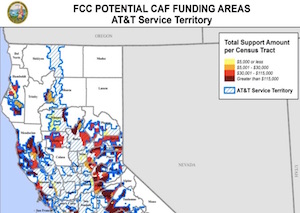
Click for the full picture.
It’s easy to think that the California you see is the California you have. If you live and work in, say, the Bay Area or Los Angeles, California is a mix of freeways, strip malls and offices packed with creative, tech savvy people. That view, or something not far from it, is what 95% of Californians see. But it’s only 5% of the state.
The other 5% of Californians and 95% of the state is rural. That includes farms and ranches, and forests, mountains and deserts. I drove from Buellton to Sacramento yesterday: six hours of fast driving with not a single sushi bar or Google bus in sight.
That urban/rural split – the rural digital divide that focused attention at the assembly select committee hearing in Sacramento this week – showed up in broadband statistics compiled by the California Public Utilities Commission for that hearing. Commissioner Catherine Sandoval outlined the broadband service issues that arise from that split, and the funding available to address them, for committee members.
Only 2% of the 95% of Californians who live in urban areas are without wireline broadband service that meets the state’s minimum 6 Mbps down/1.5 Mbps, according to stats presented by Rob Osborne, a communications analyst with the CPUC. Even if the standard was raised to the federal 25 Mbps down/3 Mbps up level, only 3% would lack sufficient service.
It’s a different story for rural residents, though. More than half – 57% – lack wireline service that meets the CPUC’s minimum, and that figure jumps to nearly two-thirds – 65% – if you use the federal standard. Upgrading broadband infrastructure in urban areas where population – and money – densities are high is a problem with a wealth of workable solutions. The challenge is developing an equally effective broadband development tool kit for rural areas.
